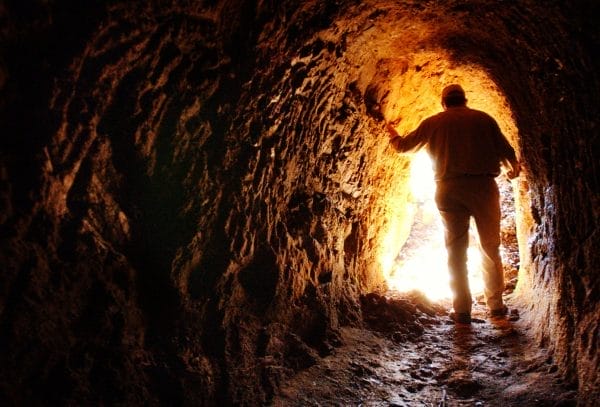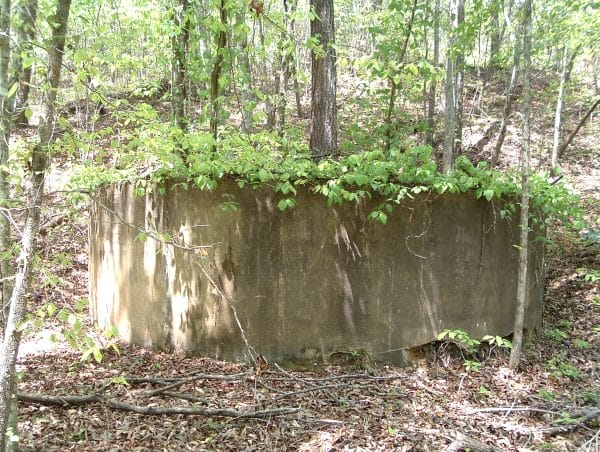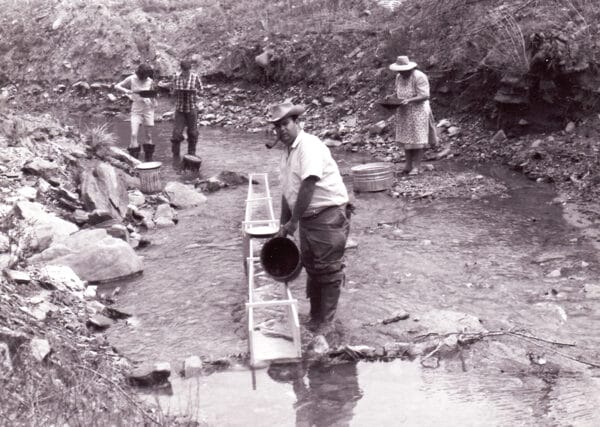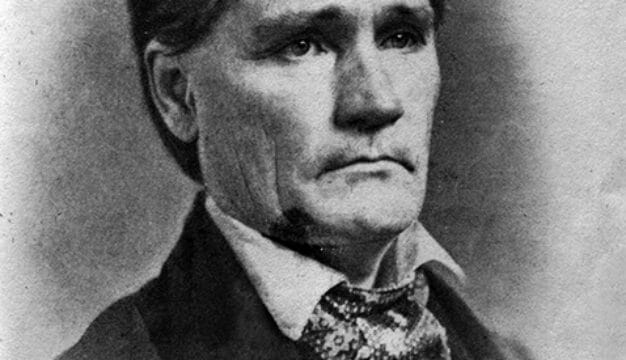Gold Production in Alabama
 Goldville Mine
The state of Alabama has produced a significant amount of gold since it was first discovered in Chilton County in the late 1830s. The year 1836 marked the beginning of the height of gold mining efforts in Alabama. One of the early gold districts, Arbacoochee, provided employment to perhaps 600 men and by 1845 was home to about 5,000 people. Goldville, another Alabama gold district, was said to have had 14 stores and a population of at least 3,000. The gold rush in Alabama generally ended in 1849, when most gold miners left the state to join the California Gold Rush. Gold prospecting in Alabama revived in 1853, however, when Cornish miners migrated from Tennessee to search for copper. There was another revival of gold mining in the 1880s and 1903, but no large quantities of gold were ever produced.
Goldville Mine
The state of Alabama has produced a significant amount of gold since it was first discovered in Chilton County in the late 1830s. The year 1836 marked the beginning of the height of gold mining efforts in Alabama. One of the early gold districts, Arbacoochee, provided employment to perhaps 600 men and by 1845 was home to about 5,000 people. Goldville, another Alabama gold district, was said to have had 14 stores and a population of at least 3,000. The gold rush in Alabama generally ended in 1849, when most gold miners left the state to join the California Gold Rush. Gold prospecting in Alabama revived in 1853, however, when Cornish miners migrated from Tennessee to search for copper. There was another revival of gold mining in the 1880s and 1903, but no large quantities of gold were ever produced.
Gold can be found in the igneous and metamorphic rocks of Alabama’s Piedmont physiographic section. The Wedowee Schist, a metamorphic rock found in northeastern Alabama that formed at the same time as the Appalachian Mountains, is known to contain gold. Recorded gold-mining districts in the state tend to follow a general southwest-northeast trend roughly lining up with the Appalachian Mountain range. The largest occurrence was found in the Hog Mountain District of Tallapoosa County in 1839. It has produced about 25,000 ounces of gold, or about half of Alabama’s total gold production. Other major districts include the Eagle Creek and Goldville districts of Tallapoosa County and the Arbacoochee district of Cleburne County.
 Leaching Vat
Gold was extracted both from underground mines and through a technique known as placer mining. In this type of mining, gold nuggets are retrieved from stream beds and rivers, where they collect after weathering out of softer rocks, or are washed out of gravels by running the material through sluices, or water channels. Instead of nuggets, most of the gold in Alabama occurs as small grains that are difficult to extract directly from the rock. Miners typically used a process called amalgamation, in which liquid mercury was poured into the substrate, causing the gold particles to dissolve and join with the mercury to form amalgam. Miners also used cyanide to dissolve gold out of source rocks by placing the gold-bearing ore into large vats and pouring cyanide and mercury onto the ore. Through a chemical process, the gold would bind to the cyanide and mercury and could then be collected from the liquid at the bottom of the vat. The large vats, abandoned mine shafts, and trenches used during this process can still be found today in some Alabama counties. Such mining techniques cause serious contamination of groundwater.
Leaching Vat
Gold was extracted both from underground mines and through a technique known as placer mining. In this type of mining, gold nuggets are retrieved from stream beds and rivers, where they collect after weathering out of softer rocks, or are washed out of gravels by running the material through sluices, or water channels. Instead of nuggets, most of the gold in Alabama occurs as small grains that are difficult to extract directly from the rock. Miners typically used a process called amalgamation, in which liquid mercury was poured into the substrate, causing the gold particles to dissolve and join with the mercury to form amalgam. Miners also used cyanide to dissolve gold out of source rocks by placing the gold-bearing ore into large vats and pouring cyanide and mercury onto the ore. Through a chemical process, the gold would bind to the cyanide and mercury and could then be collected from the liquid at the bottom of the vat. The large vats, abandoned mine shafts, and trenches used during this process can still be found today in some Alabama counties. Such mining techniques cause serious contamination of groundwater.
 Gold Panning in Chilton County
Many communities in east-central Alabama, though mainly in Tallapoosa, Randolph, and Coosa counties, credit their formation to the gold-mining operations that were established in the mid-nineteenth century. The town of Goldville in northern Tallapoosa was named for the main resource of the area. It was founded in 1842, and during the peak mining period of the 1840s, the town was home to several thousand people. The community of Arbacoochee in Cleburne County was a bustling town of nearly 5,000 people during the 1840s. The economies of these towns centered on the gold mines, with mining companies paying between $0.75 and $1.75 per day in wages during the peak of production in the mid-1840s. Some of the larger mining camps gave rise to various gambling establishments, saloons, and brothels. The population in many of these once bustling towns dropped to almost zero with the closing of the mines. Gold mining and panning is still popular as a hobby, and there are several gold bearing streams and branches in the Talladega National Forest and on private property.
Gold Panning in Chilton County
Many communities in east-central Alabama, though mainly in Tallapoosa, Randolph, and Coosa counties, credit their formation to the gold-mining operations that were established in the mid-nineteenth century. The town of Goldville in northern Tallapoosa was named for the main resource of the area. It was founded in 1842, and during the peak mining period of the 1840s, the town was home to several thousand people. The community of Arbacoochee in Cleburne County was a bustling town of nearly 5,000 people during the 1840s. The economies of these towns centered on the gold mines, with mining companies paying between $0.75 and $1.75 per day in wages during the peak of production in the mid-1840s. Some of the larger mining camps gave rise to various gambling establishments, saloons, and brothels. The population in many of these once bustling towns dropped to almost zero with the closing of the mines. Gold mining and panning is still popular as a hobby, and there are several gold bearing streams and branches in the Talladega National Forest and on private property.
Further Reading
- Lesher, Michael C., Robert Cook, and Lewis Dean. “Gold Deposits of Alabama.” Geological Survey of Alabama Bulletin 136, 1989.
- Park, Charles F. “Hog Mountain Gold District, Alabama.” New York: American Institute of Mining, Metallurgical, and Petroleum Engineers, 1935.
- Phillips, William Battle. “A Preliminary Report on a Part of the Lower Gold Belt of Alabama in the Counties of Chilton, Coosa, and Tallapoosa.” Geological Survey of Alabama Bulletin 3, 1892.



